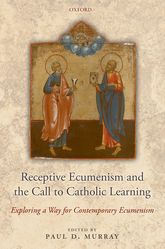 When I originally learned about the concept of receptive ecumenism and the movement to more fully reach across lines of faith traditions as a means of ecclesiastical growth, my first reaction was to ask the question – what about women in the pews?
When I originally learned about the concept of receptive ecumenism and the movement to more fully reach across lines of faith traditions as a means of ecclesiastical growth, my first reaction was to ask the question – what about women in the pews?
Dr. Paul Murray from Durham University conceived of the idea of receptive ecumenism, which had three international conferences of church leaders and theologians working together in a way that looks to learn from each other. The focus is not that our religion is better than yours, rather what can we learn from your faith tradition that could enrich ours without compromising our tradition. With this final conference and after years of lectures, meetings, and publications, Dr. Murray sent this concept out into the world to see if it had legs – and it really does. Pope Francis embraced this concept, so has the Anglican Church. The movement is also thriving in Australia to the point that eighteen delegates were present at June’s meeting in Fairfield, Connecticut. For my part, I raised the question whether or not the Catholic Church was postured to engage fully in this dialogue. Essentially, it boils down to this, how can we have an inter-faith dialogue when we are unwilling, as a church, to have an intra-faith dialogue that includes all voices. The teachings of the Second Vatican Council laid the groundwork for ecumenical dialogue to occur at a multilateral levels. The council mandated us to look inward as well.
 The Decree on Ecumenism [Unitatis Redintegratio], states that the church has a duty to make a careful and honest appraisal of whatever needs to be renewed in the Catholic household itself. According to Paul Murray, “the ecumenical problem consists not simply in breaches of affection, shared prayer, and witness – all of which occur within each of the Christian traditions and not simply between them – but ministerial, and sacramental divisions, that, over centuries have fomented and cemented such breakdowns.” (See Paul Murray, The Ecumenist, 2). Reception requires churches to be self-critical and to be open to conversion and renewal. (G. Kelly, A New Ecumenical Wave, 5). This, as Gerard Kelly points out, is an idea that goes back to the earliest Christian witness and is important in shaping the faith, life and witness of the people (G. Kelly, Receptive Ecumenism, 3). This normally occurred through liturgical, spiritual, and theological life of the Church. Today, Gerard Kelly believes that receptive ecumenism is a way for the Churches to learn, grow and change – a means to become truer to their apostolic origins and a means of offering a gift to the entire church (G. Kelly, Receptive Ecumenism, 4).
The Decree on Ecumenism [Unitatis Redintegratio], states that the church has a duty to make a careful and honest appraisal of whatever needs to be renewed in the Catholic household itself. According to Paul Murray, “the ecumenical problem consists not simply in breaches of affection, shared prayer, and witness – all of which occur within each of the Christian traditions and not simply between them – but ministerial, and sacramental divisions, that, over centuries have fomented and cemented such breakdowns.” (See Paul Murray, The Ecumenist, 2). Reception requires churches to be self-critical and to be open to conversion and renewal. (G. Kelly, A New Ecumenical Wave, 5). This, as Gerard Kelly points out, is an idea that goes back to the earliest Christian witness and is important in shaping the faith, life and witness of the people (G. Kelly, Receptive Ecumenism, 3). This normally occurred through liturgical, spiritual, and theological life of the Church. Today, Gerard Kelly believes that receptive ecumenism is a way for the Churches to learn, grow and change – a means to become truer to their apostolic origins and a means of offering a gift to the entire church (G. Kelly, Receptive Ecumenism, 4).
The aim is to seek after appropriate ecumenical ethic and strategy for the living between the times; for living now orientated upon the promise of and calling to being made one in the Trinitarian life of God” (P. Murray “The Ecumenist”). Also important is to find an appropriate means of continuing to walk the way of conversion towards more visible structural and sacramental unity. In other words, the church needs to look with fresh eyes at their own situation, particularly the challenges and threats they face.
Arguably even the current dialogue that exists today, is not fully representative of as the Church as a whole. Sister Carol Zinn points out that “the way that religion has understood women in relationship to God has been through the lens of men.” Cardinal Suenens’ observation at the Second Vatican Council supports this – “half of humanity is not represented.” Twenty-three women were invited to “audit” the second Vatican Council, they were not allowed to participate.
So where do we go from here? Pope Paul VI in Ecclesiam Suam expressed profound conviction that “the church must enter into dialogue with the world which it lives.” I think the same statement is true today.
Currently women in the Church have very limited power of persuasion, but no voice or vote. Jorge Bergoglio (now Pope Francis), in 2010 stated that “The feminine presence in the Church has not been emphasized much because the temptation of chauvinism has not allowed for the place that belongs to the women of the community to be made very visible.”
Women are desirous of serving the Church not being servants of the Church; a distinction that Pope Francis is quite aware of and beginning to address. He also stated that women must have a greater presence in the decision-making areas in the Church, and seems to be doing something about it.
On July 3, 2014, Pope Francis appointed Franciscan Sr. Mary Melone as rector of the Pontifical University in Rome. In May, four lay women – Marie Collins, Dr. Catherine Bonnett, Sheila Hollins, and Hanna Suchocka – were appointed to an eight member Vatican commission for the protection of children. The significance is that all of these positions are usually reserved for Cardinals and high-ranking clerics.
Lisa Cahill from Boston College, believes that the Pope is making a more “holistic, cultural shift within the Church.” He is not changing laws, but customs and expectations. I agree. Change occurs slowly in the Church, and as an undergraduate, I learned that this occurs with language. Dr. George Matjeka told me to watch the language out of the Vatican. Once the language changes and is accepted, then bigger changes will occur.
For now, it is important for women to act within the framework that is permitted, which includes bringing women into more key positions in the Vatican as consultants and theologians; hold leadership positions where ordination is not a prerequisite. Elizabeth Tenety suggests mapping an affirmative action plan for women to occupy Curia positions, such as members of the Congregation for the Doctrine of Faith. Encourage women to work as chancellors of dioceses around the world. With the priest shortage, it is also advantageous for women to become pastoral associates. Ashley McGuire recommends that the Vatican convene a Council of Women theologians, activists, educations and leaders at all levels to help the hierarchy address “the issues women are struggling with and helping the church then to present church teaching back to women in a way that reaches women.”
Bottom line, if we truly want to embrace the fuller multilinear faith within the Roman Catholic Church, we need have an intra-faith dialogue, listen to all of our members, include women in all dialogues and role in the Church.
Michele Stopera Freyhauf is a doctoral Student in the Department of Theology and Religious Studies and a Member of the Centre for Catholic Studies at Durham University as well as an Instructor at John Carroll University’s Department of Theology and Religious Studies and Ursuline College. Michele has an M. A. in Theology and Religious Studies from John Carroll University, and did post-graduate work at the University of Akron in the area of History of Religion, Women, and Sexuality. She is also a Member-at-Large on the Student Advisory Board for the Society of Biblical Literature and the student representative on the Board for Eastern Great Lakes Biblical Society (EGLBS). Michele’s research interests involve feminism, gender, and sexuality influenced by religion with special emphasis on the Biblical text, religious syncretism, literary analysis, politics, and law. She is also interested in gendered violence, historical theology, and ecclesiology. Michele is a feminist scholar, activist, and author of several articles including “Hagia Sophia: Political and Religious Symbolism in Stones and Spolia” and lectured during the Commission for the Status of Women at the United Nations (2013 and 2014). Michele can be followed on Twitter @msfreyhauf and @biblicalfem. Her website can be accessed here and is visible on other social media sites like LinkedIn and Google+.


The picture of two men engaging in conversation on the poster speaks for itself. I agree with your critique.
Judith Plaskow and I have concluded from our interfaith dialogue that commitment to the flourishing of the world is more important than religious or theological differences. What if we began a truly ecumenical and interfaith dialogue with the question: how can my tradition promote the flourishing of the world? Of course such a question requires a prior answer to the question: Is the flourishing of the world the proper purpose of religions?
For those who answer yest, this question could inspire an interfaith dialogue that would not focus on theological/doctrinal differences.
LikeLike
I would like to think that women serving in high levels of the Catholic Church is a step in the right direction. However, there’s still the fundamental problem that daughters of the patriarchy must serve the father. Unless a divine father/mother God/Goddess is embraced, Catholic women will always be the second sex.
LikeLike
One must however be careful not to use “receptive ecumenism” as a cover for misappropriating the traditions of other faiths. I have seen a number of progressive Protestant churches, as well as Anglicans, adopting a series of spiritual practices from East Asian, South Asian and Native American traditions without really assessing whether such action might do injustice to the original traditions and ethnic heritage. Even though almost all religions on earth had heavily borrowed from one another over centuries, I am cautious about this.
In my local neighborhood there is a Roman Catholic parish where a woman had served as the “Pastoral Administrator” for nearly 30 years: she does everything a typical clergyperson does, she is the executive director of the parish and its programs, she even preaches in the mass every other week, except for the sacraments. A semi-retired priest serves as the “Priest Moderator,” whose role is almost entirely ceremonial. So it is possible within the existing system to creatively address the issue of clergy shortage and involving more women in parish life. Unlike Anglicans, though, the Catholics operate on the system in which one set of canon laws apply to the whole world. I can imagine how difficult it is to change anything without creating disunity somewhere. Even in the Anglican Communion where each diocese is given more independence, the consecration of the Rt. Rev. +Gene Robinson caused several U.S. dioceses and a number of national provinces to severe ties to the Episcopal Church.
LikeLike
It boggles the mind that no one thinks to consider the outreach of Jesus to the marginated in the Gospels, versus the self-serving, patriarchal authority of the religious leaders of his time!
LikeLike